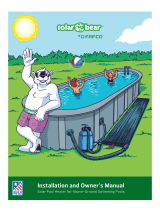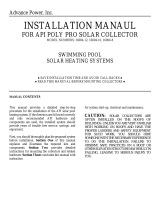
Rinnai 10 Split Solar OIM
HIGHELECTRICITYORGASBILL
Hot water usage patterns ElectricBoostedSystems-StandardSolarController:
If using an o peak (overnight) boosted electrical system with a Standard Solar
Controller, the time of use of the water may aect whether heating is done by electric
element or solar energy� This is because both solar heated water and electrically
heated water are stored in the same cylinder� (This is not a problem with gas boosted
systems, and is less of an issue with mid element storage cylinders as the electric
element only heat the top half of the tank, leaving half the tank for solar energy)�
If the bulk of hot water is used in the morning, there will be cold water in the cylinder for
the sun to heat during the day leading to lower electricity usage�
If the bulk of the hot water is used in the evening, the electric element will reheat the
water overnight� In the morning there will be no cold water in the storage cylinder for the
sun to heat�
Consider changing your usage pattern to optimise solar energy usage�
ElectricBoostedSystems-DeluxeSolarController:
If using the Deluxe Solar Controller, the time of use of the water may aect whether
heating is done by electric element or solar energy� This is because both solar heated
water and electrically heated water are stored in the same cylinder�
If insucient hot water remains for use, the controller will turn the electric element on to
heat a small quantity of water. If this occurs often, the electricity bill may be higher than
expected�
Consider changing your usage pattern to optimise solar energy usage�
High electricity cost ElectricBoostedSystems:
The electricity tari will determine the running costs of the system. Contact the
electricity supplier to conrm what these taris are.
When using a deluxe controller, a daily sterilisation boost can occur between 2 am and
6 am� Ensure that the time is correctly set on the controller and that this boosting time
matches any lower price electricity taris.
Solar control unit switched
o
If a standard solar controller is switched o there will be no solar pre-heating of water,
resulting in the water being heated entirely by electricity or gas boosting�
If a deluxe solar controller is switched o, there will be no solar preheating and no
electric boosting�
Check the power outlet for the solar control unit is switched on
Mid Sensor not in place
(DeluxeControlleronly)
If the mid sensor is not installed properly, it may be detecting a lower than the actual
temperature and turning the element on more than required.
See controller manual for more details�
Temperatureandpressure
relief valve / expansion
control valve discharging
water continuously
See entry under ‘Insucient or No Hot Water’
Lack of solar gain Reduced sunlight due to overcast weather in summer or low solar contribution in winter
will result in an increased dependence on electricity or gas boosting� Higher electricity
or gas bills under these conditions, especially in winter, are normal�
If the solar collectors are shaded by trees or other objects, or the glass is dirty, the
eectiveness of the collectors is greatly reduced. Arrange for trimming of trees or
relocation of the solar collectors if the obstruction is permanent� Arrange for cleaning of
the collector glass
Solar collectors incorrectly positioned will also severely aect the solar gain. Check that
positioning and alignment of solar collectors is in accordance with the section ‘System
Orientation and Inclination’ in the solar collector installation manual�
SAVE A SERVICE CALL


























